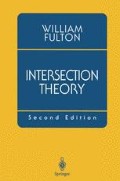Abstract
If D is a Cartier divisor on a scheme X, and αis a k-cycle on X, we construct an intersection class
where \( {\left| D \right|^1} \), \( \left| \alpha \right| \) are the supports of D and α. For α = [V], V a subvariety, D · [V] is defined by one of two procedures: (i) if \( V \not\subset \left| D \right| \), D restricts to a Cartier divisor on V, and D · [V] is defined to be the associated Weil divisor of this restriction; (ii) if \( V \subset \left| D \right| \), the restriction of the line bundle \( {\theta _x}\left( D \right) \) to V is the line bundle of a well-defined linear equivalence class of Cartier divisors on V, and D · [V] is represented by the associated Weil divisor of any such Cartier divisor.
We prove that if a is rationally equivalent to zero on X, then D·α is zero in \( {A_{k - 1}}\left( {\left| D \right|} \right) \) ; there are therefore induced homomorphisms
In the special but important case where D is the inverse image of a point for a morphism from X to a smooth curve, D·α is the specialization of α; in this case (or whenever D is principal) D·α can be well-defined as a cycle, setting \( D \cdot \left[ V \right] = 0 \) if \( V \subset D \) The above fact therefore includes the assertion that rational equivalence is preserved under specialization.
If D and D’ are Cartier divisors on a scheme X, and a is α k-cycle on X,a crucial property is the commutative law
in \( {A_{k - 2}}\left( {\left| D \right| \cap \left| {D'} \right| \cap \left| \alpha \right|} \right) \) Consider, for example, the case where \( f:X \to {\mathbb{A}^2} \) is a morphism, and D and D’ are the inverse images of the two axes. One may specialize a cycle first to the part of X over the x-axis, and then specialize the resulting cycle to f -1(0); or one may first specialize over the y-axis, then over the origin. The resulting cycles one arrives at by these two routes may well be different2, but the above says they are rationally equivalent.
Both of the above facts follow from the identity (Theorem 2.4):
for Cartier divisors D, D’ on an n-dimensional variety X, with [D], [D’] their associated Weil divisors.
A Cartier divisor D on a scheme X determines a line bundle \( L = {\copyright_X}(D)\) and a trivialization of L over X—|D| . Only the line bundle, the support, and the trivialization are needed to carry out the above intersection construction’. These concepts are formalized in the notation of a pseudo-divisor (§ 2.2); there is the added advantage that a pseudo-divisor, unlike the stricter notion of a Cartier divisor, pulls back under arbitrary morphisms
Intersecting with divisors is used to construct homomorphisms
for a line bundle L on X, and to construct Gysin homomorphisms
when i is the inclusion of an effective Cartier divisor D in X. These operations will be generalized to higher codimension in subsequent chapters.
Article Footnote
1This shorthand for Supp (D) should not be confused with a notation for complete linear systems, which do not occur in this chapter.
2 This corresponds to the fact that a family of cycles parametrized by a smooth parameter variety has a unique limiting cycle over a missing point when the parameter variety is a curve, but not when it has dimension two or more.
Access this chapter
Tax calculation will be finalised at checkout
Purchases are for personal use only
Preview
Unable to display preview. Download preview PDF.
Author information
Authors and Affiliations
Rights and permissions
Copyright information
© 1998 Springer Science+Business Media New York
About this chapter
Cite this chapter
Fulton, W. (1998). Divisors. In: Intersection Theory. Springer, New York, NY. https://doi.org/10.1007/978-1-4612-1700-8_3
Download citation
DOI: https://doi.org/10.1007/978-1-4612-1700-8_3
Publisher Name: Springer, New York, NY
Print ISBN: 978-0-387-98549-7
Online ISBN: 978-1-4612-1700-8
eBook Packages: Springer Book Archive

